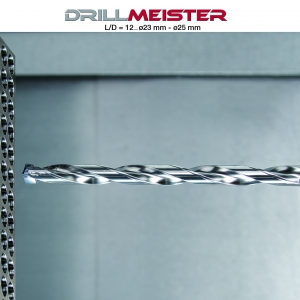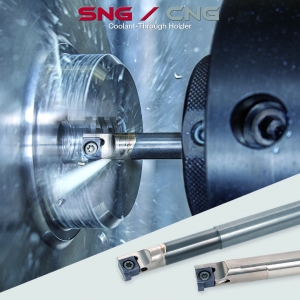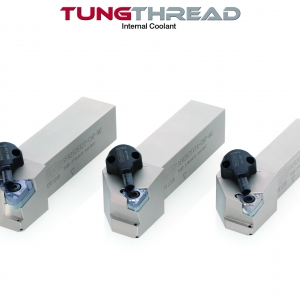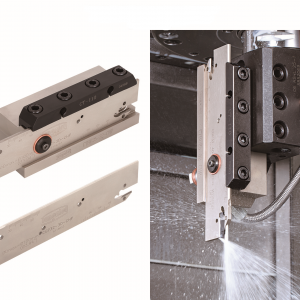Contact Details

Tungaloy has expanded its multifunctional turning and boring capabilities of the TungBore-Mini line by adding boring toolholders that accommodate its unique XOMU inserts.
TungBore-Mini is a multifunctional drilling and turning tool line that integrates the capabilities of drilling, OD, and ID turning tools. Its unique XOMU insert features an innovative geometry incorporating a large inclination angle on the cutting edge that produces light cutting, compared with standard ISO positive turning inserts that are typically used for ID turning or boring operations. In addition, TungBore-Mini’s insert and pocket have a dovetail interlocking design providing better insert clamping and stability than standard screw-down insert clamping, ensuring process security during various applications.
The latest toolholders incorporate innovative designs that ensure secure ID machining processes. The toolholder is designed to provide an ample clearance between the tool and the hole surface through which chips that generated during boring or ID turning are smoothly evacuated out of the small diameter bores. In addition, with Tungaloy’s angled screw fixation method, an engaged screw not only presses the insert against its primary support on the bottom of the insert, but also pulls the insert into the pocket wall. This design also allows a longer screw to be used providing strong insert retention and process security.
The new toolholders are available for minimum bore diameters of either 10 mm or 14 mm, with either a steel or carbide shank. Total of eight toolholders have been added.
Related Glossary Terms
- boring
boring
Enlarging a hole that already has been drilled or cored. Generally, it is an operation of truing the previously drilled hole with a single-point, lathe-type tool. Boring is essentially internal turning, in that usually a single-point cutting tool forms the internal shape. Some tools are available with two cutting edges to balance cutting forces.
- clearance
clearance
Space provided behind a tool’s land or relief to prevent rubbing and subsequent premature deterioration of the tool. See land; relief.
- inclination angle
inclination angle
Angle that the cutter edge makes with a plane that is perpendicular to the direction of tool travel. Determines the direction the chip curls.
- inner diameter ( ID)
inner diameter ( ID)
Dimension that defines the inside diameter of a cavity or hole. See OD, outer diameter.
- outer diameter ( OD)
outer diameter ( OD)
Dimension that defines the exterior diameter of a cylindrical or round part. See ID, inner diameter.
- shank
shank
Main body of a tool; the portion of a drill or similar end-held tool that fits into a collet, chuck or similar mounting device.
- toolholder
toolholder
Secures a cutting tool during a machining operation. Basic types include block, cartridge, chuck, collet, fixed, modular, quick-change and rotating.
- turning
turning
Workpiece is held in a chuck, mounted on a face plate or secured between centers and rotated while a cutting tool, normally a single-point tool, is fed into it along its periphery or across its end or face. Takes the form of straight turning (cutting along the periphery of the workpiece); taper turning (creating a taper); step turning (turning different-size diameters on the same work); chamfering (beveling an edge or shoulder); facing (cutting on an end); turning threads (usually external but can be internal); roughing (high-volume metal removal); and finishing (final light cuts). Performed on lathes, turning centers, chucking machines, automatic screw machines and similar machines.










 PRODUCTS
PRODUCTS

